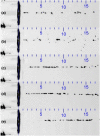Working principle and relevant physical properties of the Swiss Liquid Jet Aesthesiometer for Corneal Sensitivity (SLACS) evaluation
- PMID: 35156726
- PMCID: PMC9305237
- DOI: 10.1111/opo.12962
Working principle and relevant physical properties of the Swiss Liquid Jet Aesthesiometer for Corneal Sensitivity (SLACS) evaluation
Abstract
Purpose: To describe and evaluate relevant physical properties of the Swiss Liquid Jet Aesthesiometer for Corneal Sensitivity (SLACS) for ocular surface sensitivity measurement.
Methods: Characteristics of Liquid Jet (LJ) droplets (consisting of isotonic saline solution) were analysed: vertical and horizontal displacement and speed of LJ droplets were recorded with the aid of the High Speed Photron FASTCAM NOVA S6 camera (stimulus duration: 40 ms). Stimulus mass was assessed for 20 sets of 10 LJs with aid of a microbalance (pressure range of 100-1500 mbar).
Results: Because continuous flow LJ disintegrated into droplets in the lower pressure range (<700 mbar), pulsed stimuli were applied in order to obtain similar stimulus characteristics across the applied pressure range. For all measurements, very little variability was observed. Vertical and horizontal displacement did not exceed 0.13 mm in either direction. The mass per shot showed an unexpected cubic dependency on pressure. Up to approximately 700 mbar, LJ speed showed an almost linear relationship. For the pressure range of >700-1500 mbar, variability increased and speed decreased compared to the expected in a linear manner. However, this may be caused by the difficulty of identifying pattern changes of LJ droplets from one high speed image frame to the next with increasing stimulus speed, when determining LJ speed via pixel count.
Conclusions: Swiss Liquid Jet Aesthesiometer for Corneal Sensitivity was shown to deliver fine droplets with a pulsed stimulus mode, in a repeatable manner with precise localisation to the ocular surface. Very little variability was observed in LJ speed and mass for the typical pressure range required for clinical sensitivity measurements.
Keywords: cornea; corneal sensitivity; liquid jet aesthesiometry.
© 2022 The Authors. Ophthalmic and Physiological Optics published by John Wiley & Sons Ltd on behalf of College of Optometrists.
Conflict of interest statement
The authors report no conflicts of interest and have no proprietary interest in any of the materials mentioned in this article.
Figures










Similar articles
-
Corneal Nerve Assessment by Aesthesiometry: History, Advancements, and Future Directions.Vision (Basel). 2024 May 12;8(2):34. doi: 10.3390/vision8020034. Vision (Basel). 2024. PMID: 38804355 Free PMC article. Review.
-
Clinical application of the Swiss Liquid Jet Aesthesiometer for corneal sensitivity measurement.Clin Exp Optom. 2024 Jan;107(1):14-22. doi: 10.1080/08164622.2023.2191782. Epub 2023 Apr 5. Clin Exp Optom. 2024. PMID: 37019837
-
Stimulus characteristics of a novel air-based multiple stimulus aesthesiometer.Ophthalmic Physiol Opt. 2024 Jan;44(1):32-41. doi: 10.1111/opo.13252. Epub 2023 Nov 23. Ophthalmic Physiol Opt. 2024. PMID: 37994563
-
Does air gas aesthesiometry generate a true mechanical stimulus for corneal sensitivity measurement?Clin Exp Optom. 2018 Mar;101(2):193-199. doi: 10.1111/cxo.12603. Epub 2017 Sep 18. Clin Exp Optom. 2018. PMID: 28922696 Clinical Trial.
-
Proposal for a new approach to corneal biomechanics: dynamic corneal topography.Arq Bras Oftalmol. 2009 Mar-Apr;72(2):264-7. doi: 10.1590/s0004-27492009000200028. Arq Bras Oftalmol. 2009. PMID: 19466344 Review.
Cited by
-
Corneal Nerve Assessment by Aesthesiometry: History, Advancements, and Future Directions.Vision (Basel). 2024 May 12;8(2):34. doi: 10.3390/vision8020034. Vision (Basel). 2024. PMID: 38804355 Free PMC article. Review.
-
Evaluation of Corneal Sensitivity: Tools We Have.Diagnostics (Basel). 2025 Jul 15;15(14):1785. doi: 10.3390/diagnostics15141785. Diagnostics (Basel). 2025. PMID: 40722534 Free PMC article. Review.
-
Non-contact confocal calcium imaging of in vivo murine corneal nerves.Biomed Opt Express. 2024 Dec 3;16(1):1-11. doi: 10.1364/BOE.543333. eCollection 2025 Jan 1. Biomed Opt Express. 2024. PMID: 39816143 Free PMC article.
References
-
- Müller LJ, Marfurt CF, Kruse F, Tervo TMT. Corneal nerves: structure, contents and function. Exp Eye Res 2003;76:521–42. - PubMed
-
- Rózsa AJ, Beuerman RW. Density and organization of free nerve endings in the corneal epithelium of the rabbit. Pain 1982;14:105–20. - PubMed
-
- Acosta MC, Tan ME, Belmonte C, Gallar J. Sensations evoked by selective mechanical, chemical, and thermal stimulation of the conjunctiva and cornea. Invest Ophthalmol Vis Sci 2001;42:2063–7. - PubMed
-
- Belmonte C, Carmen Acosta M, Gallar J. Neural basis of sensation in intact and injured corneas. Exp Eye Res 2004;78:513–25. - PubMed
Publication types
MeSH terms
LinkOut - more resources
Full Text Sources
Medical

